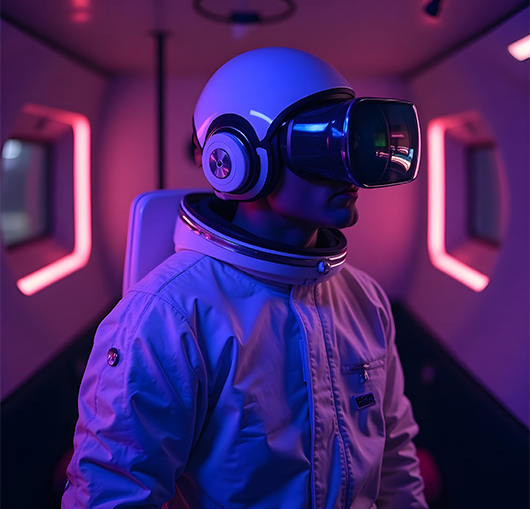How Pixar and DreamWorks are Experimenting with Immersive Films
The future of animation is not only what appears before us, but more about the experience of the same. As immersive tech is expected to have more than 171 million VR users around the globe, and is expected to increase by 2025, the industry is already transforming the way in which brands are engaged by consumers.
The large players in the industry, Pixar and DreamWorks, are augmenting boundaries outside the cinema screens, venturing into immersive media, such as Virtual Reality (VR), 360 o film, and mixed media.
Here in this article, we will plunge into true experiments, technology solutions, their implications on storytelling, and how both studios may form the next generation of animated entertainment.
Key Takeaways:
- Pixar is in the process of using VR in storytelling (Coco VR) and pre-production (just like with Elio).
- DreamWorks has been the first to put immersive technologies such as Super Cinema, Dreamscape VR, and 4-D motion entertainment experiences.
- The immersive films generate stronger emotional appeals as well as provide new opportunities both in terms of creativity and commerce.
- They both are experimental, but remain on the edge of issues such as interactivity, affordability, and accessibility to the audience.
For business, now’s the time to lean into immersive content creation.
1- The Emergence of Creative Storytelling
Immersive film can be comprehended as those narrative experiences that put audiences into the world of the story, by any means of technology, such as VR/AR, 360 cameras, and even with built-in scale physical environments. In animation, this will be breaking the fourth wall. The skills of Pixar and DreamWorks are built on telling stories, which provide an opportunity for the audience to be a part of the world.
2. Pixar VR and Interactive Story Making
– Coco VR
- A multiplayer virtual reality VR experience introduced in November 2017 through the Oculus Rift, Coco VR allows a visitor to experience the colorful Land of the Dead seen in the film Coco. Players will have the ability to explore gondolas, attend markets, play with Hector, design costumes, and lots more.
- The project is an Emmy award-nominated, Clio innovation award-winning work assembled by Magnopus with Pixar. According to a comment by Pixar technical director John Halstead, they wanted something with an “active experience, not a passive viewing” experience.
– VR Tools College Project Elio
When creating Elio (2025), Pixar produced VR equipment on pre-production, allowing the artists the possibility of moving and modifying the settings in real-time, assessing lighting, size, and moods within VR prior to final animation.
– Oculus Story Studio and Henry
- In 2014, Pixar defectors established the Oculus Story Studio and created a VR animated short called Henry that starred a hedgehog who had a big hug obsession. In 2016, it won an Emmy award as an Outstanding Interactive Program.
- Henry demonstrated the ability of VR to build empathy by having characters stare at the viewers directly, right-eye up, and you see the power of interaction, which makes a film an emotional two-way experience
When I stare at Henry, he will stare back at you, and your eyes in the VR have to be front and center because that is the most important part about the VR experience.
– VR Caveats: VR as Narrative
- Ed Catmull, the co-founder of Pixar, warns that VR might not be ready to substitute linear storytelling: It is not storytelling. Gaming is its art form.
- Still, Pixar is not afraid to experiment to fill the gap between fiction and reality, trying out new applications and even forms of work such as SparkShorts or AR overlays
3. Innovation of DreamWorks at 360 & VR Format
– Super Cinema: Pre-Rendered 360 VR Cine Films
In 2014, DreamWorks introduced a technology dubbed Super Cinema, a technology to broadcast pre-rendered 360-degree CGI films in a format that can be viewed with VR head-tracking without compromises to the visual fidelity end of the chain.
This method sews together so-called photospheres of high-resolution frames, and the gaze is so immersive, even on mid-range VR devices.
– Stereoscopic 3D InTru3D
In 2008, DreamWorks partnered with Intel to develop InTru3D-a workflow, which allows stereoscopic 3D animation. It was applied in Monsters vs. Aliens, How to Train Your Dragon, Puss in Boots, etc.
– DreamWorks Theatre: The Physical Immersion:
Located at Universal Studios Hollywood and inaugurated in 2018, DreamWorks Theatre uses a motion-simulator experience in projection mapping and 4-D effects, including such franchises as Kung Fu Panda
– VR Dragons Flight Academy
DreamWorks funded Dreamscape Immersive to develop Dragons Flight Academy (Dec 2019). This full-roam VR experience allows players to use motion capture and body movement to feel like they are flying on dragons that are set in the How to Train Your Dragon universe.
Location-Based VR developed by Dreamscape Immersive
Dreamscape Immersive uses VR headsets, body tracking, and live stages. Their first DreamWorks effort was Alien Zoo, released in 2018, and was succeeded by attractions such as the Curse of the Lost Pearl, Men in Black, and Dragons Flight Academy.
4. The Reason Behind Why Studios Are Embracing Immersive Media
– Connection & Emotional resonance
Immersive forms enhance the emotional appeal to bring the viewer into the realm of story-empathy and stronger involvement.
– Inventive Loop & Productivity
VR applications, such as in Elio, enable pre-visualization of spaces and lighting, which has previously been done through costly physical mock-ups.
– Cross-Platform Storytelling
Physical (motion-simulator), head-mounted (VR), and mobile (360 video) forms create new megatons of channels – theme parks, in the home, and mobile forms of storytelling such as SparkShorts.
– New Revenue Generation & Branding
The immersive attractions within parks, malls, and theaters will mix up the generated revenues, widen the branded reach, and attract new audiences.
5. Difficulties & Drawbacks
- Storytelling Mechanics: VR requires the promotion of interactive, player-managed narration stories, yet Pixar focuses on controlled storytelling rather than in-world strolling.
- Technical Limitations: rendering of high fidelity 360 has huge amounts of file size, storage, and requires precise optimization- DreamWorks solved this when it pre-rendered frames with its Super Cinema.
- Available and Affordable: High-quality needs physical space and investment: theme-park installations, and location-based VR. There is still restricted and hardware-specific use of Home VR.
6. What’s Next? The Way Forward
- Immersive Film Awards, Cannes: In 2024, Cannes introduced awards in VR/AR cinematic storytelling, a sign of industry-wide international validation.
- Hybrid Productions: We are going to experience increased cross-breeding of linear and immersive styles, such as Super Cinema, 4-D experiences, and SparkShorts, with mobile-friendly interaction.
- Institutional Use: Universities and museums are also moving to using VR to tell stories and do immersive learning, in a parallel process to studio experiments.
7. Animation Implications in Your Business
- If you’re offering 2d/3d animation services, Virtual Reality solutions, or tools like an animated cartoon movie maker, this arena offers new horizons:
- Partner with studios that require VR pre-vis to support movie-type projects or VR-specialized storytelling.
- Construct modules or assets of immersive experiences (360 video, AR filters, motion-sim attractions).
- Create coaster-based, physical-based experiences within branding concepts that desire to involve fan experiences.
Summing Up
The not-so-new concepts of interactive Coco VR tours to the adrenaline-rushing Dragons Flight Academy are not experiments, but rather the blueprints of a massively immersive multiverse of animated experiences developed by Pixar and DreamWorks. With the increasing accessibility of VR/AR technology, the world can expect a rush of immersive media, a combination of animation, interactivity, and emotion.
For studios, animators, and digital agencies, this represents an invitation: adapt your Virtual Reality solutions, expand your 2d/3d animation services, and explore immersive storytelling with a tool like animated cartoon movie maker. Readers are willing to enter into your animation scenes- do you feel like being their guide?
Want to Build Worlds, not Just Content- Discover VR with Digital Gravity.
At Digital Gravity, we do not make animations; we create immersive worlds. Whether you’re looking to develop a full-scale VR experience, enhance your marketing with interactive 360° content, or bring your story to life through virtual simulations, our expert team delivers cutting-edge Virtual Reality solutions tailored to your brand. Be ready to give your audience an insider view of your story? It is time to create your next experience world.


